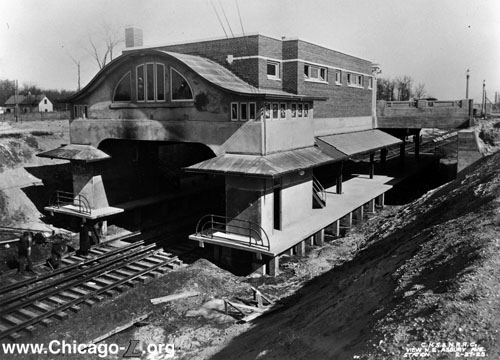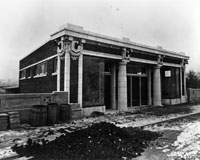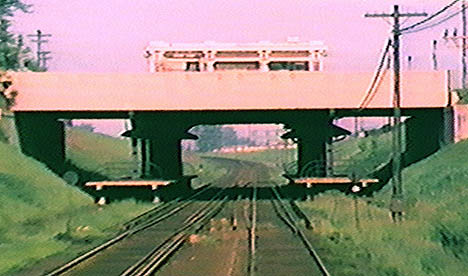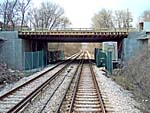
The Asbury station, looking
southwest circa 1924-25 during the station's construction.
The station was an usual mix of styles: at street level
(facing the bridge), it was a Beaux-Arts station similar to South
Blvd, Sheridan, Wilson and others; facing the tracks, it more closely resembled the
Mediterranean style of the North Shore Line's Skokie Valley
stations. For a larger view, click here. (Photo
from the J.J. Sedelmaier Collection) |
Asbury
(1300W/200N)
Asbury Street and Brummel
Street, City of Evanston
Service
Notes:

|
North Side
Division, Niles Center branch
|
Quick Facts:
Address: 220-222 Asbury Avenue
Established: March 28, 1925
Original Line: n/a
Previous Names: none
Skip-Stop Type: n/a
Rebuilt: n/a
Status: Demolished
History:

The Asbury station house, designed in the Beaux Arts style common to many "L" stations of the time, is seen looking northwest on March 2,1925. The finishing touches are still being put on the new facility, which would open less than a month later. For a larger view, click here. (Photo
from the J.J. Sedelmaier Collection) |
When the Yellow Line first operated
as the Niles Center branch of the Chicago Rapid Transit Company
(1925-1948), there were a number of stops between the two
terminals. This was one of three stations in Evanston (the
others were Ridge and Dodge)
on the east-west leg of the Niles Center branch.
Asbury station's entrance was located on the bridge over
the tracks. While the tracks below carried trains of both the "L" and the North Shore Line interurban, only "L" trains stopped at the station. Designed by Arthur U. Gerber, the station had an
clever mix of styles. The front and side elevations,
visible from the street, were designed in a style familiar to many "L" riders, resembling stations Gerber
designed at Sheridan, South
Boulevard, and Central among
other locations. The building combined elements of Doric and Beaux Arts designs,
executed in terra cotta. Trademark Gerber details included
the laurel-framed cartouches, pair of Greek Revival Doric
columns framing the entrance, globed lights and the words
"Rapid Transit" above the front door in Terra Cotta. The
interior was executed in smooth art marble with a spacious
fare control area. On the street elevation, two retail
spaces were provided on either side of the entrance. Inside,
these flanked a corridor that led to the fare controls,
which were located at the back of the building.
The rear elevation of the building, however, was a
distinctively different style. Encompassing elements such as
a stucco exterior, arched windows, and tile roofs over the
stairs and platforms, the design of the rear elevation is
largely influenced by the Mediterranean style. This
Spanish-influenced style makes sense, as the North Shore Line stations on the same line north of Dempster used this style. Thus, Gerber designed the
Asbury station such that from the street it resembled the
typical stations he was designing for the rapid transit
system at that time, but from track level it resembled the
other stations on the North Shore Line, whose trains passed
the station.
 
Left: A view
of the platforms at Asbury. These short platforms
could only hold, at most, two CRT cars. The stairs
from the station house are in enclosures at the
background of the platforms. The circular bend of
the ends of the platform railings is typical on the
"L", seen at many stations, like Morse for instance. For a larger view, click here. (Photo from North
Shore Line, from Sunday River
Productions)
Right: The
former location of Asbury station as it appears
today, looking west in December 2002. A small
portion of the outbound platform remains, housing a
communications hut, though not enough to fully
berth a car. For a larger view, click here. (Photo by Graham
Garfield) |
The station had short, dual side platforms which could
accommodate no more than two or three "L" cars at a time.
The east ends of the platforms were covered by the street
viaduct, while the west ends were protected by the depot
building overhead and hipped roofs that projected from the
underside of the building. Stairs lead from the station
house's rear to the west end of the short platforms.
On March 27, 1948, the
CTA abandoned service
over the Niles Center Line, closing the station and replacing the "L" service with the #97 Skokie bus route.
The North Shore Line abandoned their Skokie Valley Route (including the former Niles Center Line "L" tracks) in
January 1963, though the Asbury station hadn't been in service since March 1948.
Following the abandonment of the North Shore Line, the CTA began to pursue the reactivation of the tracks as far north as Dempster, the same stretch served by "L" trains between 1925 and 1948. Funded as a "demonstration project" for a duration of two years beginning in April
1964 by the Department of Housing and Urban Development, the reestablished service, coined the Skokie Swift, was a nonstop shuttle
between Howard at the
Chicago city limits and Dempster in Skokie. All of the
intermediate stations were to remain closed and local service would
continue to be provided by the #97 Skokie bus. Asbury station's demolition wasn't included in the budget of
the Skokie Swift's construction (though Main, Oakton,
Kostner and East Prairie were),
and the station survived until the mid- to late-1970s,
housing a convenience/grocery store. By the mid-1980s, the
station building was completely gone and the bridge largely
rebuilt.
Today, a small portion of one the platforms remains under
the viaduct. The east end of the north (westbound) platform
remains, housing communications huts. In 2005-06, the Asbury
bridge was rebuilt and although this removed more small
remnants of the old station, the small stretch of the
outbound platform still remains.
A New In-fill Station in South Evanston
Discussion of adding local stations between Howard and Dempster began almost immediately after the Skokie Swift began operations in 1964. In 1969, consultants Pratt and Bevis of Washington D.C.
were hired to investigate the extension of the Skokie Swift to Lake Cook Road. As part of this, the
reinstitution of a stop at Asbury was considered (along with
a new station at Hamlin in Skokie), but the plans for a new station were not pursued.
Serious study of constructing a new "in-fill" station on the Yellow Line in Evanston resumed in the 2000s, lead primarily by the City of Evanston. In 2007, the City joined the Village of Skokie and the Regional Transportation Authority in a project, the Skokie Swift North Shore Corridor Travel Market Analysis, to examine how to expand the Yellow Line. In addition to identifying major travel patterns and markets that could support a line extension, the study also evaluated three potential new station locations in south Evanston -- at Dodge, Asbury, and Ridge. The study found that depending on location, a new station could expand the total number of work trips served by the Yellow Line by 25 to 45 percent and attract up to 1,000 riders per day, potentially more if the Yellow Line offered direct service to downtown Chicago. However, the study identified no single station location as clearly superior to the others based on the criteria. The study recommended that the relative costs of constructing a station at one or more of the locations be evaluated in an engineering feasibility study to provide clearer direction on a preferred station location(s).1
As recommended by the 2007 study, the City of Evanston initiated the Yellow Line Station Engineering Feasibility Study Project in 2011 to study and determine which location was best suited for a new station. In January 2012, the study identified Asbury as the best location for a new Yellow Line station in south Evanston.2
Ridge was the first location to be eliminated by the committee due to its close proximity to the existing Howard and South Boulevard stations.3
When comparing Dodge and Asbury, officials found that the area around Dodge is less densely populated than Asbury, reducing the potential for walk-in traffic or traffic generators to draw destination ridership. Another key factor against the Dodge station location, officials said, is that the existing 85-year-old bridge over Dodge Avenue would need to be reconstructed to support a new station, adding another $10 million to the capital costs. Dodge, however, garnered more support than Asbury in an online survey, officials said. Of the 426 respondents, 249 preferred Dodge to Asbury, with 51 respondents saying both locations were ideal.4
A primary benefit to Asbury is that a new CTA station could best impact the surrounding area, officials said. "The area along Howard near Asbury is a potential area that could be the focus of future redevelopment efforts," said Tom Coleman, a consultant with Parsons Brinckerhoff.5
While local officials think an Asbury station makes the most sense, much needs to be done before it is built. Officials estimate that an Asbury station could cost about $23 million to build, and $900,000 annually to operate. Acquiring federal dollars, which city engineer Paul Schneider said could potentially cover about 70 to 80 percent of the building cost, would require "a bit of a sales job" to convince the federal government of the station's merits and growth potential. If Evanston secures federal funds for a Yellow Line station, the city would still need to kick in about $6 million as a local match, Schneider said. That money could come from the state or from the city, he added, perhaps through creation of a tax increment financing district.6
Officials said the committee would conclude its feasibility study in February 2012 and present its findings to Evanston's City Council for approval.7 Following approval of the study and recommended location by the City Council in April 2012, the Illinois Department of Transportation would begin engineering design for the site and conduct a detailed analysis of construction costs and environmental impact, as well as get more input from the community. The first phase of the IDOT study could cost $1 million to $1.6 million.8 Funding would also still need to be identified to construct and operate the station.

The Asbury station, circa
1960. The relatively small station house was located on the
bridge over the tracks, a practice somewhat unusual when the
station built in 1925, but commonplace today in many places
like the Forest Park, O'Hare and Dan Ryan Lines. It was
abandoned at the time of this photograph, taken from a
moving North Shore Line train.
(Photo from North Shore Line, from Sunday River
Productions)
|


|
asbury05.jpg
(273k)
In 2005-06, the Asbury bridge was rebuilt. Although this
removed more small remnants of the old station, this view
looking west on April 12, 2006 shows that a small stretch of
the outbound platform will still remain to support the
communications huts under the viaduct.
(Photo by William Davidson)
|

Thanks to J.J. Sedelmaier for the information on the stations
post-1948 status.
Notes:
1. "About the Project," Yellow Line Station Engineering Feasibility Study. evanstonyellowlinestation.org. Accessed on 22 February 2012.
2.
Bullington, Jonathan. "Study points to Asbury for possible Yellow Line station." TribLocal: Evanston. 25 January 2012.
3. Ibid.
4. Ibid.
5. Ibid.
6. Ibid.
7. Ibid.
8. Bullington, Jonathan. "Site for new Evanston stop on CTA's Yellow Line faces funding hurdle."Chicago Tribune. 16 April 2012.








